Ducks can be easily identified by the color of their plumage. Contrary to popular belief, most ducks aren’t white and they actually do come in other colors, especially black.
Black ducks are often wild species, but there are domesticated black ducks that are being raised as pets and on the farms. In this article, we will explore 11 black duck breeds.
Table of Contents
1. American Black Duck
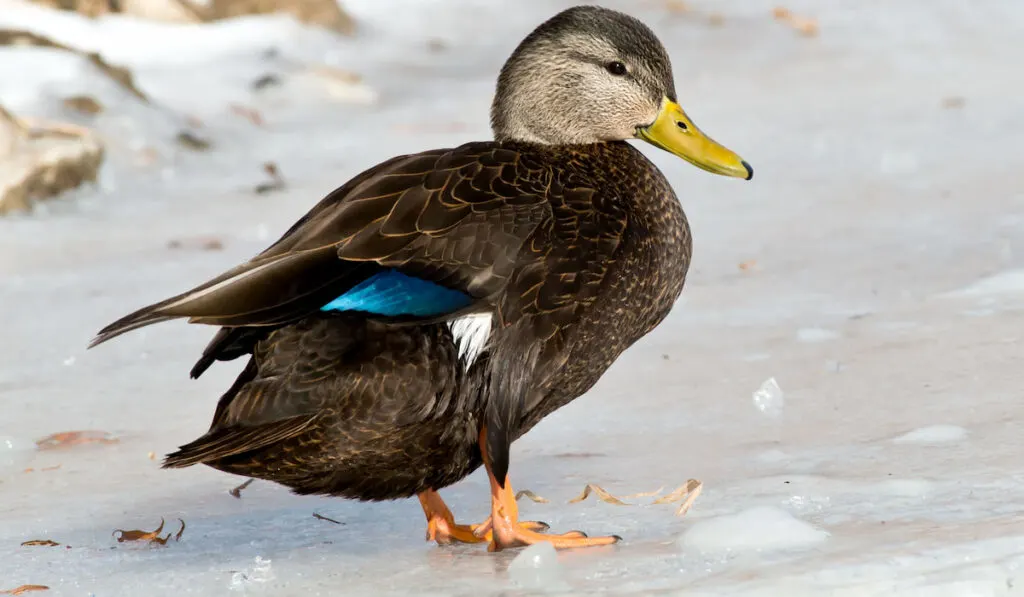
American Black ducks are commonly found along the Atlantic coast and the Mississippi flyways. These large ducks will migrate to the region between Long Island and North Carolina in the winter.
The American Black duck has a blackish-brown body with a greenish-yellow bill and iridescent purple patches on its upper wings. The female has slightly paler and duller colors than the males.
This duck mostly inhabits coastal wetland areas, and fresh and saltwater marshes. Being a dabbling duck, it feeds on small aquatic animals, amphibians, mollusks, crustaceans, as well as small water plants.
Female American Black ducks lay between 6 to 14 creamy white to greenish pale eggs.
2. African Black Duck
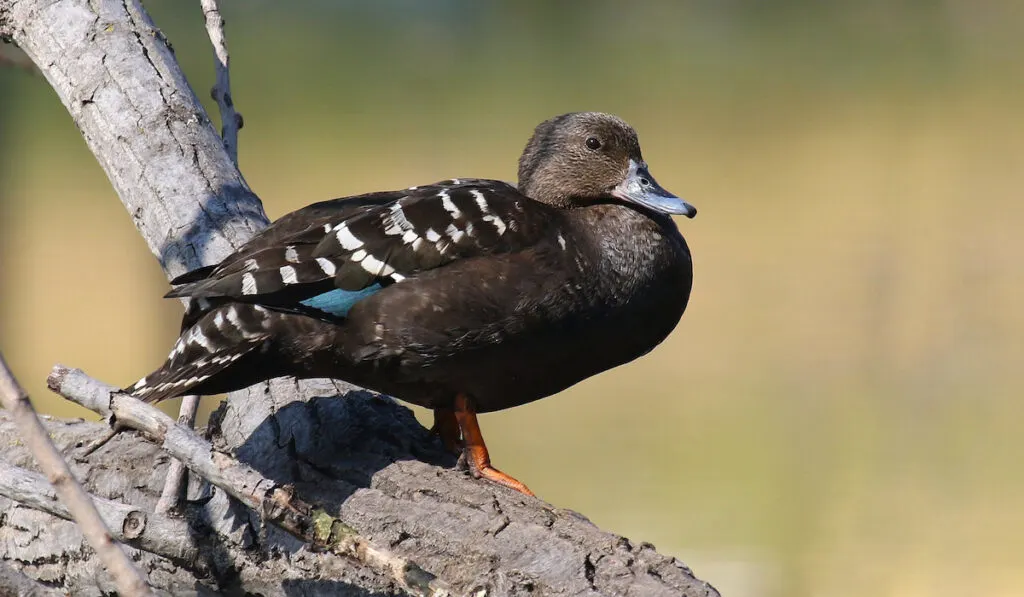
The African Black duck comes in black or dark brown colors with a pale and black bill, orange legs, and white markings on its back.
It can be found commonly in the East and South sub-Saharan Africa. This duck also prefers shady, fast-flowing shallow rivers, ponds, and streams with rocky structures.
The African Black duck is mostly active at dawn and dusk. It has a shy, territorial personality, and can be seen in pairs or small groups.
This duck mainly feeds on aquatic insects, crustaceans, small fish, crabs, and water plants. The females lay clutches of between 4 and 7 creamy white to buff-yellow eggs before the males guard them for 28 to 32 days.
3. Black Scoter Duck
This sturdy, medium to large-sized sea duck can be found in coastal regions and along rocky coastlines, especially in the Northeast of the United States.
Black scoters have black plumage with a bright yellowish-orange knob on the bill. Female black scoters are slightly different with a brown body, pale cheeks, and a dark cap.
This diving duck feeds on a variety of foods like mollusks, crustaceans, aquatic insects, small fish, fish eggs, and occasionally, some water plants.
The female lays 8 to 9 whitish to pale buff eggs before incubating them for 27 to 31 days.
Being a highly vocal sea duck, the black scoter will croon a soft, low call that is similar to the sound of doves.
4. East Indie Duck
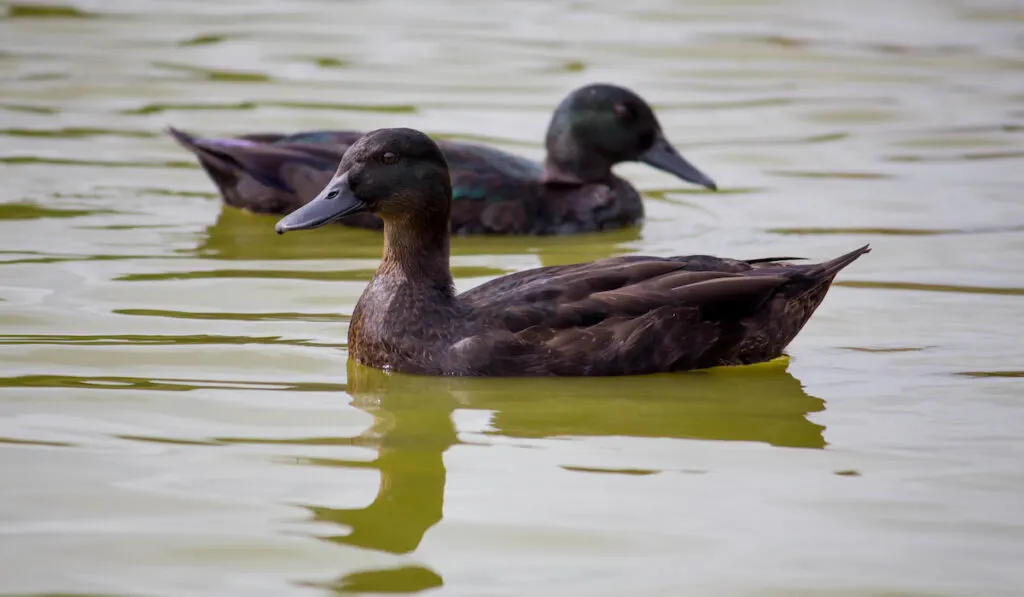
Also known as the Black East Indian, this duck is the oldest breed of bantam duck. Its origin is still unclear.
Some people believe that the East Indie duck came from Buenos Aires through importation, while others believe it originated in America in the 19th century.
However, this duck was standardized in the UK in 1895 and recognized by the American Poultry Association’s Standard of Perfection in 1874.
East Indie ducks can be recognized by their striking iridescent blackish-green plumage, a black bill and black legs, and a female with dull or pale gray plumage. Some people would confuse this breed with the Cayuga duck but they are two different breeds.
Female East Indies lay between 10 and 25 black or gray eggs. Over time, these eggs will turn to light gray or blue colors.
This duck mostly feeds on seeds, crustaceans, microbes, as well as bugs.
5. Pacific Black Duck
Pacific Black ducks can be found mostly in Australia. They inhabit lagoons, coastal streams, inland swamps, and freshwater regions.
This duck can be recognized by its black or dark brown plumage and distinctive dusty brown head with cream face and dark stripes. Female Pacific Black ducks will produce a loud single or repeated quack when they are distressed.
Females exhibit a unique courtship behavior where they will preen, bob, and flap their wings to attract the male. Generally, the female duck will lay 7 to 13 glossy white eggs that are oval-shaped.
The Pacific Black duck is categorized as both a diving and a dabbling duck. It mostly feeds on aquatic insects, crustaceans, shrimp, and seeds.
6. Cayuga Duck
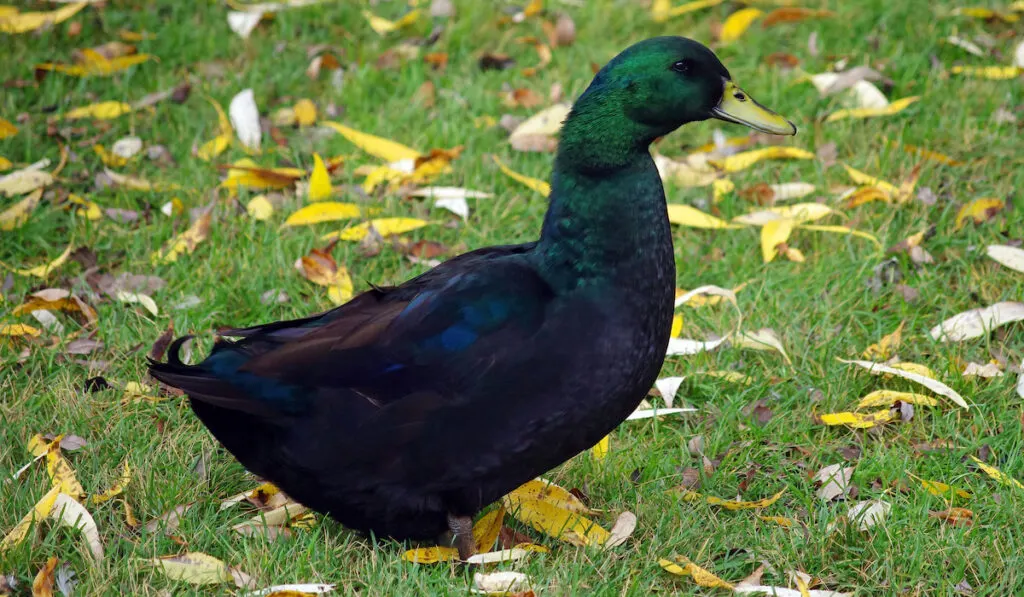
This domestic duck received its name from the Cayuga Lake located in the western part of New York, United States. It was developed by breeding two different wild ducks: the Black East Indian and the Rouen. The Cayuga duck has a distinctive iridescent, blackish-green plumage, a black bill, and legs.
Being a good forager, it feeds mostly on insects, snails, and slugs.
A healthy female Cayuga could produce between 100 to 150 eggs per year. The eggs will change their colors from black to gray, blue, green, and white as time passes.
This duck is raised for its meat, eggs, and ornamental purposes. Its quiet and docile temperament makes it easy to raise it on a small farm or even a backyard.
7. Muscovy Duck
Muscovy ducks originated in Mexico, Central, and South America.
This sturdy, large-sized duck can be recognized by its black plumage, black legs, and red warty-looking bumps on its face. Both males and females also possess white patches on their wings.
Muscovy duck inhabits watery areas in the forests. At night, it will fly up the trees to roost and nest in the tree cavities.
A female Muscovy could lay between 8 to 15 eggs. Under distress, it will become protective and defend its nest and ducklings.
Being an omnivorous duck, the Muscovy mainly feeds on a variety of things like aquatic insects, small fish, crustaceans, roots, stems, and leaves of aquatic plants.
8. Pomeranian Black Duck
This medium-sized duck originated from Pomerania, a region on the Baltic sea coast in Germany. In German, it is also known as Pommern and Pommernente.
Pomeranian black ducks come in two colors: black with shimmering green shades and blue with shimmering purple shades. The one with the blue plumage also has a big white patch on its chest.
As a dual-purpose duck, it is raised mainly for its meat and eggs. Female Pomeranians lay between 80 to 100 eggs per year. The eggs are typically white or greenish-blue in color.
This duck is also an excellent forager, a hardy breed, and easy to raise without much intervention.
9. Swedish Blue Duck
Swedish Blue duck was developed in 1835 by farmers in Pomerania before being imported into North America in 1884 and finally recognized by the American Standard of Perfection in 1904.
Like its name, this duck has a black head, grayish-blue plumage, and a white patch on its neck. The Swedish Blue is a dual-purpose duck, mainly raised for its meat and eggs.
Females lay between 100 to 150 white or green-tinted eggs per year. This duck is also considered a good pet due to its docile and calm nature.
However, the female produces a quack that sounds like a loud yell, which can be quite noisy for some people.
Although this duck is commonly known for its blue color, it could also produce ducklings that are black or gray in color.
10. White Winged Scoter
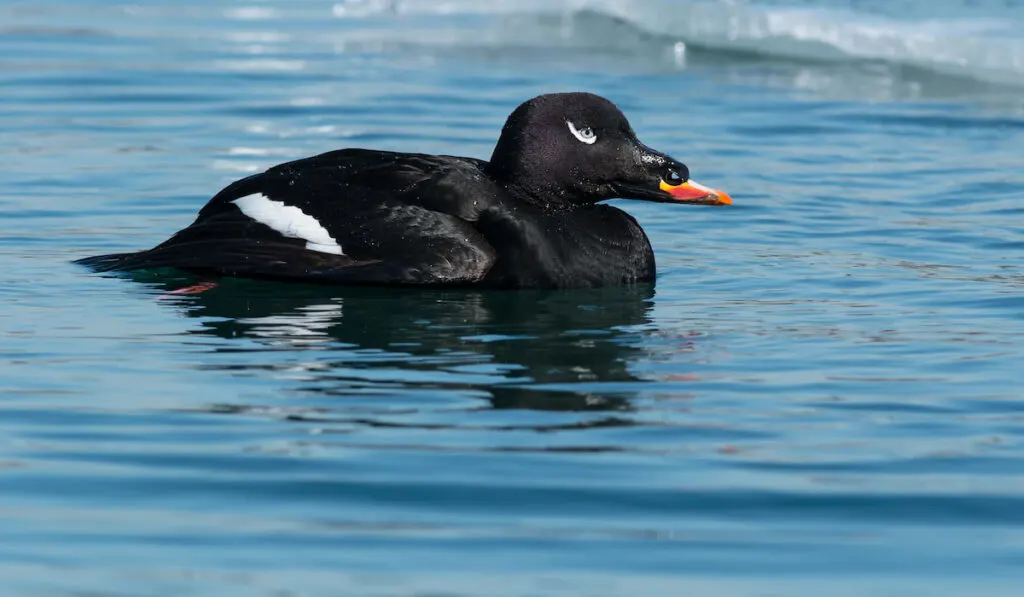
The white winged scoter is a large sea duck that inhabits coastal waters and large freshwater lakes in the northwest interior of North America. It will migrate to the Atlantic and Pacific coasts in the winter. This species is the largest among all three scoter species.
The white winged scoter can be recognized by its black or dark brown plumage with white patches on its wings, sloping forehead and bill, pink legs, and white Viking-horn-shaped patterns around its eyes. Female scoter can be differentiated from the male by its white round shapes around the eyes.
This diving sea duck feeds on crustaceans, mollusks, and aquatic insects.
The female lays 8 to 10 eggs and incubates them for 25 to 30 days.
11. Velvet Scoter
The Velvet scoter is a medium-sized diving duck that is found in coastal waters, rivers, ponds, and large inland lakes in European and Asian countries.
This scoter can be recognized by its glossy black plumage, a long yellow bill, a thick neck, and a tail that is pointed upward. It also has a white patch on its wings.
Female velvet scoters are slightly different with dark brown plumage, dark gray bills, and light gray cheeks.
Velvet scoters typically feed on mollusks, crustaceans, small fish, aquatic insects, and water plants. It will use its wings and feet to dive down into the water.
The female duck lays 7 to 9 creamy buff eggs before incubating them for 26 to 29 days.
Final Thoughts
Be it wild or domestic, all of these black duck breeds are certainly unique due to their striking black color. With this information, the next time you’re in the forests, beaches, or just taking a stroll in the wild, it will be easier for you to identify which is which!
Citations
American Black Duck
- https://www.fws.gov/uploadedFiles/Region_5/NWRS/Central_Zone/Montezuma/BlackDuckFacts.pdf
- https://www.ducks.org/hunting/waterfowl-id/american-black-duck
- https://www.allaboutbirds.org/guide/American_Black_Duck/id
African Black Duck
- https://seaworld.org/animals/facts/birds/african-black-duck/
- https://ebird.org/species/afbduc1
- http://www.oiseaux-birds.com/card-african-black-duck.html
Black Scoter Duck
- https://www.audubon.org/field-guide/bird/black-scoter
- https://www.allaboutbirds.org/guide/Black_Scoter/overview
- http://www.birdweb.org/birdweb/bird/black_scoter
East Indie Duck
- https://www.roysfarm.com/east-indies-duck/
- https://www.thehappychickencoop.com/east-indie-duck-breed/
- https://www.breedslist.com/east-indies-duck.htm
Pacific Black Duck
- https://australian.museum/learn/animals/birds/pacific-black-duck/
- http://www.wiresnr.org/pacificblackduck.html
- https://www.birdlife.org.au/bird-profile/pacific-black-duck
Cayuga Duck
- http://afs.okstate.edu/breeds/poultry/ducks/cayuga
- https://www.waterfowl.org.uk/domestic-waterfowl/heavy-ducks/cayuga/
- https://backyardpoultry.iamcountryside.com/poultry-101/cayuga-duck-breed-spotlight/
Muscovy Duck
- https://ebird.org/species/musduc
- https://www.allaboutbirds.org/guide/Muscovy_Duck/id
- https://animaldiversity.org/accounts/Cairina_moschata/
Pomeranian Black Duck
- https://www.breedslist.com/pomeranian-duck.htm
- https://domesticanimalbreeds.com/pomeranian-duck-breed-everything-you-need-to-know/
- https://www.roysfarm.com/pomeranian-duck/
Swedish Blue Duck
- https://www.beautyofbirds.com/blueswedishducks.html
- https://livestockconservancy.org/index.php/heritage/internal/swedish
- https://www.purelypoultry.com/blue-swedish-ducklings-p-861.html
White Winged Scoter
- https://www.birdweb.org/birdweb/bird/white-winged_scoter
- https://ebird.org/species/whwsco2
- https://www.allaboutbirds.org/guide/White-winged_Scoter/lifehistory
Velvet Scoter
